Seat Alhambra 2006 Owner's Manual
Manufacturer: SEAT, Model Year: 2006, Model line: Alhambra, Model: Seat Alhambra 2006Pages: 299, PDF Size: 6.33 MB
Page 261 of 299

General notes on the technical data259
Safety FirstOperating instructionsTips and MaintenanceTe c h n i c a l D a t a
How are the figures measured?
Fuel consumption
Fuel consumption and emission values are determined according to Euro-
pean Commission Directive 99/100/EC. They take the actual kerb weight
(weight class) into consideration. To calculate the consumption rate, two measuring cycles are carried out on a rolling road test bed. The test criteria
are as follows:
Note
•The fuel consumption and emission values quoted in the tables below are
based on an empty basic vehicle without optional extras. The kerb weight of
the vehicle may vary depending on the equipment fitted and thus the weight
category with a relative increase of consumption and emission of CO
2 Your
Authorised Service Centre will be able to inform you of the figures which apply
to your vehicle.
•Actual consumption may vary from quoted test values, depending on
personal driving style, road and traffic conditions, the weather and the condi-
tion of the vehicle.Urban cycle The urban cycle starts with an engine cold start. City driving is then simulated.
Extra urban cycleIn the extra urban cycle the vehicle undergoes frequent acceleration and braking in all gears, as in normal everyday driving. The
road speed ranges from 0 to 120 km/h.
CombinedThe average overall consumption is calculated with a weighting of around 37% for the urban cycle and 63% for the extra urban
cycle.
CO
2 emissionsThe exhaust gases are collected during both driving cycles to calculate carbon dioxide emissions. The gas composition is then
analysed to evaluate the CO2 content and other emissions.
Page 262 of 299
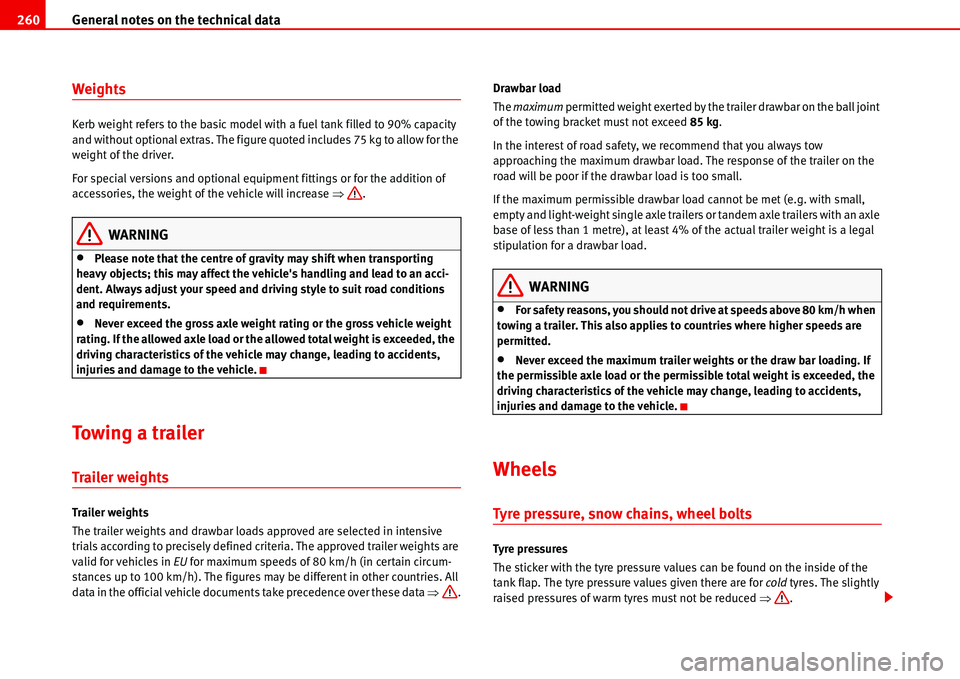
General notes on the technical data 260
Weights
Kerb weight refers to the basic model with a fuel tank filled to 90% capacity
and without optional extras. The figure quoted includes 75 kg to allow for the
weight of the driver.
For special versions and optional equipment fittings or for the addition of
accessories, the weight of the vehicle will increase �Ÿ.
WARNING
•Please note that the centre of gravity may shift when transporting
heavy objects; this may affect the vehicle's handling and lead to an acci-
dent. Always adjust your speed and driving style to suit road conditions
and requirements.
•Never exceed the gross axle weight rating or the gross vehicle weight
rating. If the allowed axle load or the allowed total weight is exceeded, the
driving characteristics of the vehicle may change, leading to accidents,
injuries and damage to the vehicle.
Towing a trailer
Trailer weights
Trailer weights
The trailer weights and drawbar loads approved are selected in intensive
trials according to precisely defined criteria. The approved trailer weights are
valid for vehicles in EU for maximum speeds of 80 km/h (in certain circum-
stances up to 100 km/h). The figures may be different in other countries. All
data in the official vehicle documents take precedence over these data �Ÿ.Drawbar load
The maximum permitted weight exerted by the trailer drawbar on the ball joint
of the towing bracket must not exceed 85 kg.
In the interest of road safety, we recommend that you always tow
approaching the maximum drawbar load. The response of the trailer on the
road will be poor if the drawbar load is too small.
If the maximum permissible drawbar load cannot be met (e.g. with small,
empty and light-weight single axle trailers or tandem axle trailers with an axle
base of less than 1 metre), at least 4% of the actual trailer weight is a legal
stipulation for a drawbar load.
WARNING
•For safety reasons, you should not drive at speeds above 80 km/h when
towing a trailer. This also applies to countries where higher speeds are
permitted.
•Never exceed the maximum trailer weights or the draw bar loading. If
the permissible axle load or the permissible total weight is exceeded, the
driving characteristics of the vehicle may change, leading to accidents,
injuries and damage to the vehicle.
Wheels
Tyre pressure, snow chains, wheel bolts
Tyre pressures
The sticker with the tyre pressure values can be found on the inside of the
tank flap. The tyre pressure values given there are for cold tyres. The slightly
raised pressures of warm tyres must not be reduced �Ÿ.
Page 263 of 299
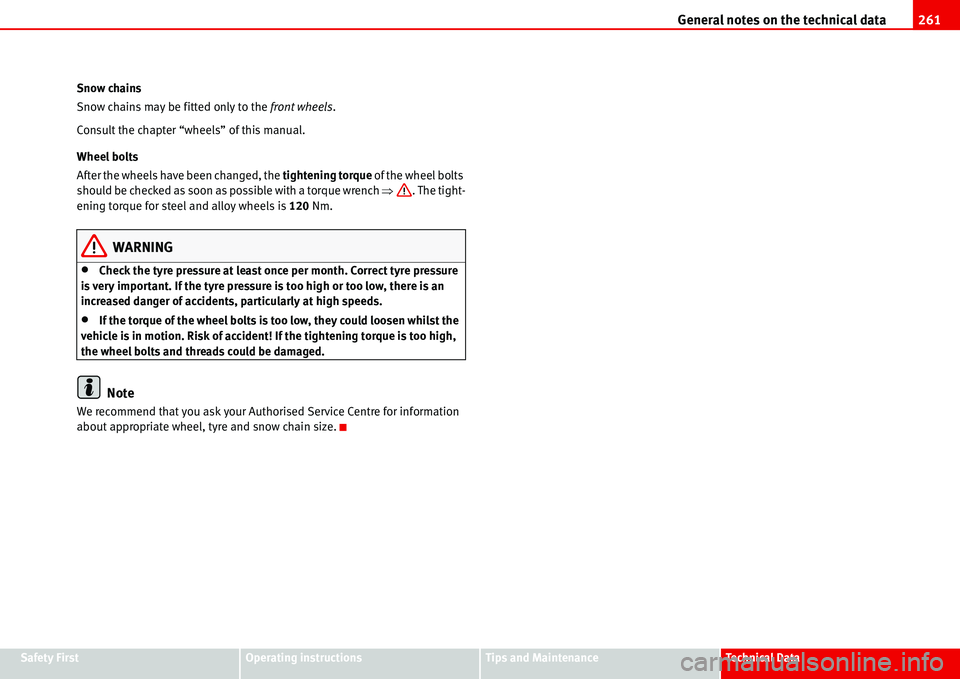
General notes on the technical data261
Safety FirstOperating instructionsTips and MaintenanceTe c h n i c a l D a t a Snow chains
Snow chains may be fitted only to the front wheels.
Consult the chapter “wheels” of this manual.
Wheel bolts
After the wheels have been changed, the tightening torque of the wheel bolts
should be checked as soon as possible with a torque wrench �Ÿ. The tight-
ening torque for steel and alloy wheels is 120 Nm.
WARNING
•Check the tyre pressure at least once per month. Correct tyre pressure
is very important. If the tyre pressure is too high or too low, there is an
increased danger of accidents, particularly at high speeds.
•If the torque of the wheel bolts is too low, they could loosen whilst the
vehicle is in motion. Risk of accident! If the tightening torque is too high,
the wheel bolts and threads could be damaged.
Note
We recommend that you ask your Authorised Service Centre for information
about appropriate wheel, tyre and snow chain size.
Page 264 of 299
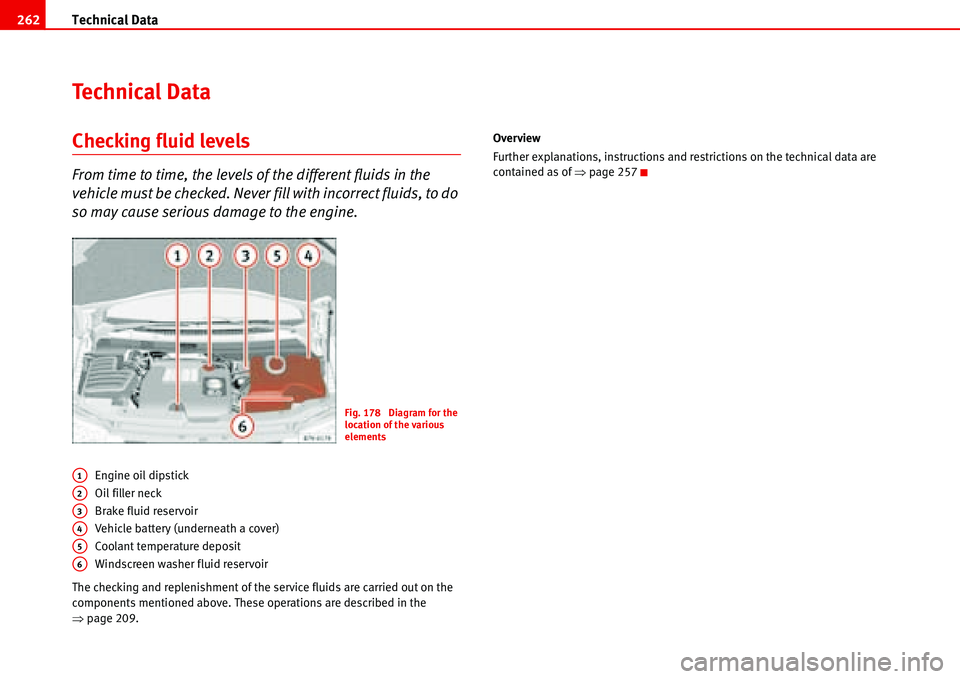
Technical Data 262
Te c h n i c a l D a t a
Checking fluid levels
From time to time, the levels of the different fluids in the
vehicle must be checked. Never fill with incorrect fluids, to do
so may cause serious damage to the engine.
Engine oil dipstick
Oil filler neck
Brake fluid reservoir
Vehicle battery (underneath a cover)
Coolant temperature deposit
Windscreen washer fluid reservoir
The checking and replenishment of the service fluids are carried out on the
components mentioned above. These operations are described in the
�Ÿpage 209.Overview
Further explanations, instructions and restrictions on the technical data are
contained as of �Ÿpage 257
Fig. 178 Diagram for the
location of the various
elements
A1
A2
A3
A4
A5
A6
Page 265 of 299
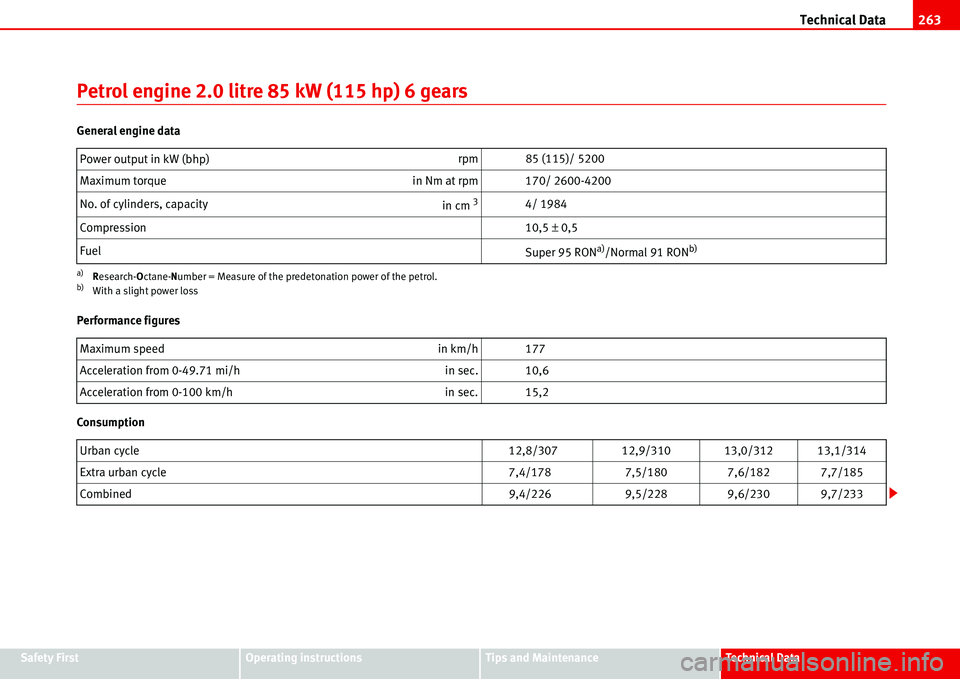
Technical Data263
Safety FirstOperating instructionsTips and MaintenanceTe c h n i c a l D a t a
Petrol engine 2.0 litre 85 kW (115 hp) 6 gears
General engine data
Performance figures
ConsumptionPower output in kW (bhp)rpm 85 (115)/ 5200
Maximum torquein Nm at rpm 170/ 2600-4200
No. of cylinders, capacity
in cm
34/ 1984
Compression 10,5 ± 0,5
Fuel
Super 95 RON
a)/Normal 91 RONb)
a)Research-Octane-Number = Measure of the predetonation power of the petrol.b)With a slight power loss
Maximum speedin km/h 177
Acceleration from 0-49.71 mi/h in sec. 10,6
Acceleration from 0-100 km/hin sec. 15,2
Urban cycle12,8/307 12,9/310 13,0/312 13,1/314
Extra urban cycle7,4/178 7,5/180 7,6/182 7,7/185
Combined9,4/226 9,5/228 9,6/230 9,7/233
Page 266 of 299
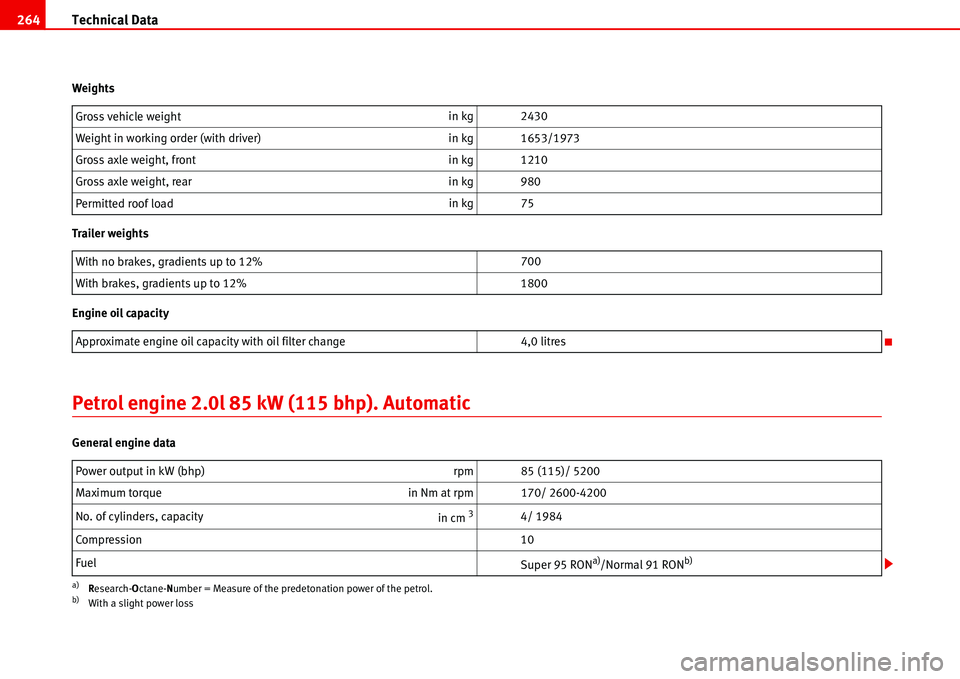
Technical Data 264
Weights
Trailer weights
Engine oil capacity
Petrol engine 2.0l 85 kW (115 bhp). Automatic
General engine dataGross vehicle weightin kg 2430
Weight in working order (with driver)in kg 1653/1973
Gross axle weight, frontin kg 1210
Gross axle weight, rearin kg 980
Permitted roof loadin kg 75
With no brakes, gradients up to 12%700
With brakes, gradients up to 12%1800
Approximate engine oil capacity with oil filter change 4,0 litres
Power output in kW (bhp)rpm 85 (115)/ 5200
Maximum torquein Nm at rpm 170/ 2600-4200
No. of cylinders, capacity
in cm
34/ 1984
Compression 10
Fuel
Super 95 RON
a)/Normal 91 RONb)
a)Research-Octane-Number = Measure of the predetonation power of the petrol.b)With a slight power loss
Page 267 of 299
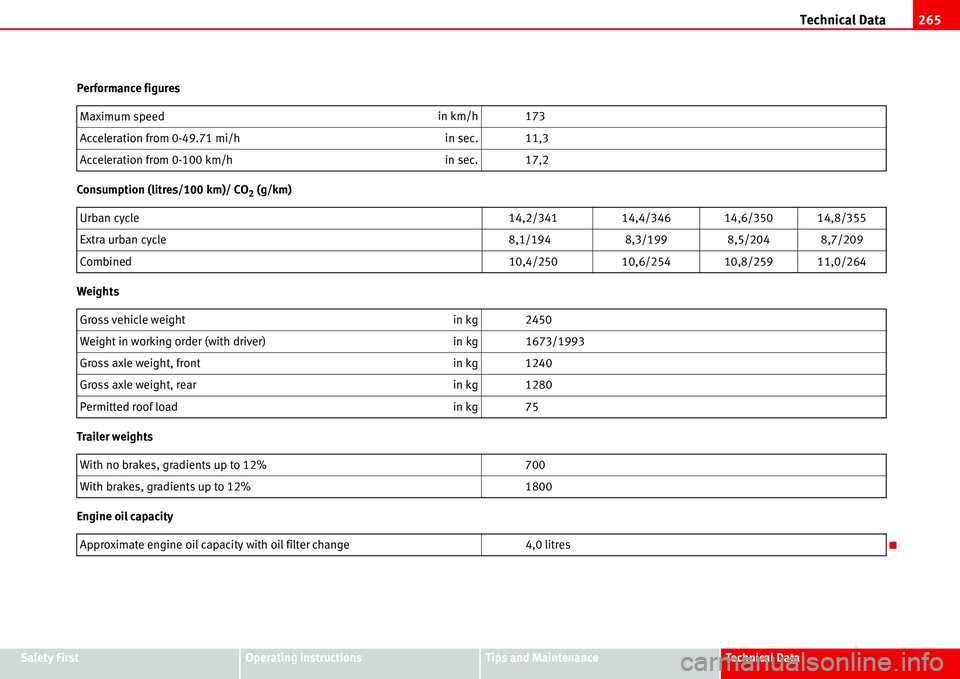
Technical Data265
Safety FirstOperating instructionsTips and MaintenanceTe c h n i c a l D a t a Performance figures
Consumption (litres/100 km)/ CO
2 (g/km)
Weights
Trailer weights
Engine oil capacityMaximum speedin km/h 173
Acceleration from 0-49.71 mi/h in sec. 11,3
Acceleration from 0-100 km/hin sec. 17,2
Urban cycle14,2/341 14,4/346 14,6/350 14,8/355
Extra urban cycle8,1/194 8,3/199 8,5/204 8,7/209
Combined10,4/250 10,6/254 10,8/259 11,0/264
Gross vehicle weightin kg 2450
Weight in working order (with driver)in kg 1673/1993
Gross axle weight, frontin kg 1240
Gross axle weight, rearin kg 1280
Permitted roof loadin kg 75
With no brakes, gradients up to 12%700
With brakes, gradients up to 12%1800
Approximate engine oil capacity with oil filter change4,0 litres
Page 268 of 299
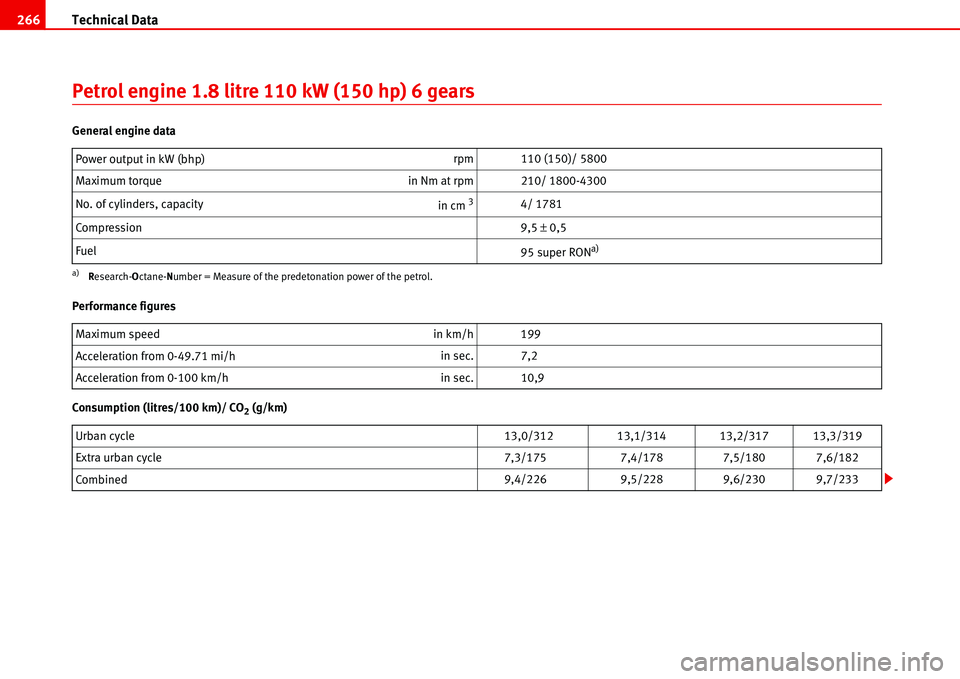
Technical Data 266
Petrol engine 1.8 litre 110 kW (150 hp) 6 gears
General engine data
Performance figures
Consumption (litres/100 km)/ CO
2 (g/km) Power output in kW (bhp)rpm 110 (150)/ 5800
Maximum torquein Nm at rpm 210/ 1800-4300
No. of cylinders, capacity
in cm
34/ 1781
Compression 9,5 ± 0,5
Fuel
95 super RON
a)
a)Research-Octane-Number = Measure of the predetonation power of the petrol.
Maximum speedin km/h 199
Acceleration from 0-49.71 mi/hin sec. 7,2
Acceleration from 0-100 km/hin sec. 10,9
Urban cycle13,0/312 13,1/314 13,2/317 13,3/319
Extra urban cycle7,3/175 7,4/178 7,5/180 7,6/182
Combined9,4/226 9,5/228 9,6/230 9,7/233
Page 269 of 299
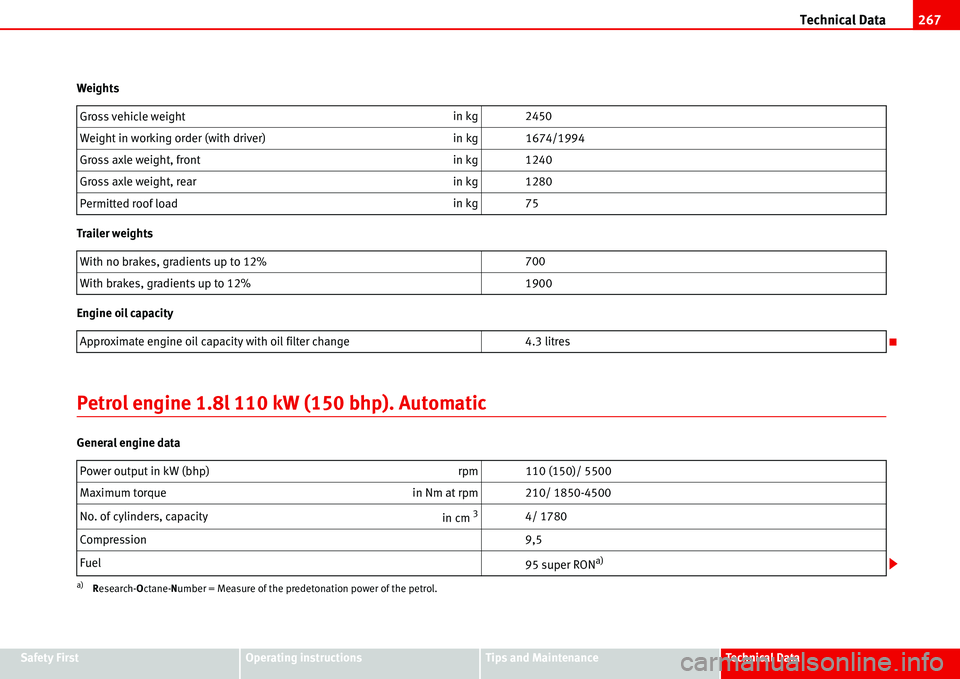
Technical Data267
Safety FirstOperating instructionsTips and MaintenanceTe c h n i c a l D a t a Weights
Trailer weights
Engine oil capacity
Petrol engine 1.8l 110 kW (150 bhp). Automatic
General engine dataGross vehicle weightin kg 2450
Weight in working order (with driver)in kg 1674/1994
Gross axle weight, frontin kg 1240
Gross axle weight, rearin kg 1280
Permitted roof loadin kg 75
With no brakes, gradients up to 12%700
With brakes, gradients up to 12%1900
Approximate engine oil capacity with oil filter change 4.3 litres
Power output in kW (bhp)rpm 110 (150)/ 5500
Maximum torquein Nm at rpm 210/ 1850-4500
No. of cylinders, capacity
in cm
34/ 1780
Compression 9,5
Fuel
95 super RON
a)
a)Research-Octane-Number = Measure of the predetonation power of the petrol.
Page 270 of 299
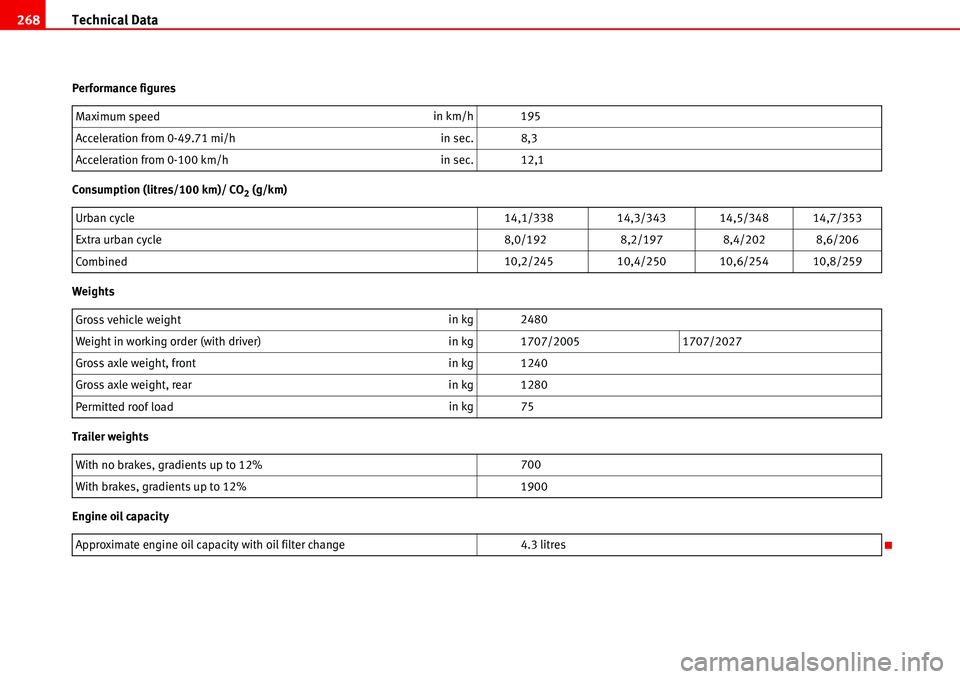
Technical Data 268
Performance figures
Consumption (litres/100 km)/ CO
2 (g/km)
Weights
Trailer weights
Engine oil capacityMaximum speedin km/h 195
Acceleration from 0-49.71 mi/hin sec. 8,3
Acceleration from 0-100 km/hin sec. 12,1
Urban cycle14,1/338 14,3/343 14,5/348 14,7/353
Extra urban cycle8,0/192 8,2/197 8,4/202 8,6/206
Combined10,2/245 10,4/250 10,6/254 10,8/259
Gross vehicle weightin kg 2480
Weight in working order (with driver)in kg 1707/2005 1707/2027
Gross axle weight, frontin kg 1240
Gross axle weight, rearin kg 1280
Permitted roof loadin kg 75
With no brakes, gradients up to 12%700
With brakes, gradients up to 12%1900
Approximate engine oil capacity with oil filter change4.3 litres